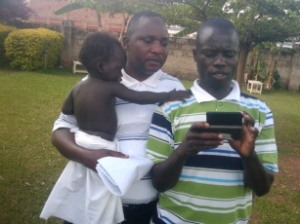After we launched our Community Knowledge Worker (CKW) network in Uganda, I was reviewing a budget report and came across a “babysitting” entry. Thinking this must be an obvious mistake, I contacted our local finance person for an explanation. I discovered that we did pay for babysitting as some of the CKWs we were training were mothers who would not have been able to participate unless we paid for child care. It makes perfect sense now and is a good example of a practical step you can take to ensure that women and men access your programs.
 At Grameen Foundation, we’ve learned first-hand the importance of doing what it takes to strive for gender equity in our work. Ensuring that women have equal access to the actionable agricultural information we provide through our CKW network is not just a “feel good” action for us. It is also one of the most practical steps we can take to achieve our goal of improving farmers’ livelihoods through access to information.
At Grameen Foundation, we’ve learned first-hand the importance of doing what it takes to strive for gender equity in our work. Ensuring that women have equal access to the actionable agricultural information we provide through our CKW network is not just a “feel good” action for us. It is also one of the most practical steps we can take to achieve our goal of improving farmers’ livelihoods through access to information.
In Uganda, women do 85% of the planting, 85% of the weeding, 55% of the land preparation, and 98% of all food processing. This may explain why 90% of rural women in Uganda work in agriculture, compared to 53% of men. According to the Food and Agriculture Organization (FAO), women in rural areas produce at least 50% of the world’s food. While women are hard at work on farms, we also know that many women do not have access to mobile phones. According to the Women and Mobile Report by the GSMA and Cherie Blair Foundation, women are 24% less likely than men to own a mobile phone in sub-Saharan Africa, and women in rural areas and lower income brackets stand to benefit the most from closing the gender gap in mobile phone ownership.
So what does this mean for our work as an organization that is building a network of trusted farmers to provide agricultural information using mobile phones? We’re fighting the mobile phone gender gap by putting phones into the hands of our female Community Knowledge workers. We have set a goal of 35% women as CKWs in our first phase and 40% in our second phase, with women making up 50% of the farmers we reach. Currently, we are at 30% female CKWs.
We have heavily weighted the agricultural information we provide toward subjects more important to women, including the on-farm crop production cycle (preparing gardens, planting and managing soils/plants). We are also scrutinizing our results though a gender-sensitive lens. For instance, we have discovered that women are much more likely go to, and even return to, a CKW for information if this worker also happens to be a woman. Of all the farmers we served, 63% of female farmers went to a female CKW for information. In addition, we saw that those that went to a female CKW return about three times in a six-week period for more information, while those who started off going to a male CKW typically did not return! We use such results to consider changes in course and approach. This is one reason we are currently working hard to increase the percentage of women CKWs we recruit.
We also are seeking solutions that relate to literacy. CKWs must be literate, and a reason we have had difficulty recruiting females CKWs is because of lower levels of literacy amongst them, compared to men in the regions in which we work. One exciting technology we are exploring now involves the delivery of agricultural information over the mobile phone using voice commands and call centers. Because this overcomes the barriers caused by illiteracy, this tool might help us reach greater numbers of women.

Comments